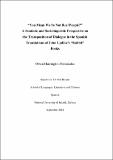| dc.description.abstract | Despite the vast amount of research on translation in recent decades, the
issue of fictive dialogue has yet to gain prominence in the field. Viewed
from a monolingual perspective, dialogue is already problematic in that it
defies a concrete definition. It is written language, yet its function is to
represent oral discourse. From a translation perspective and beyond this
ontological conundrum, dialogue warrants consideration because it is a
crucial characterisation device. The illusion of communicative
immediacy that authors create by removing themselves as proxy not only
allows characters to interact with one another directly, but also allows
readers to observe the behaviour of characters without the intrusion of the
narrator, thus raising the issue of how characters perform their identity
through language. With this in mind, the overarching question this thesis
asks is the following: if the language characters use in dialogue changes,
as it must do in translation, how does this change affect how they
perform their identity through language?
This project compares John Updike's 'Rabbit' books and their Spanish
translations to explore whether the linguistic identity of the main
character, Harry 'Rabbit' Angstrom, his wife, Janice, and the AfricanAmerican
community, are codified in the target dialogue. With regards to
translating Harry Angstrom's voice, the focus is on transposing his
source text idiolect in order to reflect salient character attributes; the
focus with regards to the African-American characters is on finding a
suitable target language vernacular that constructs an intratextual speech
community; finally, the focus for Janice's voice is on reflecting her
gender in Spanish. Informed by a theoretical framework constructed with
translation, sociolinguistic and semiotic theory, the analyses describe the
translation shifts and losses that are in evidence in the professional
translations, and put forward alternatives that recast the voice of the
characters in line with the identity described in the source narrative | en_US |


